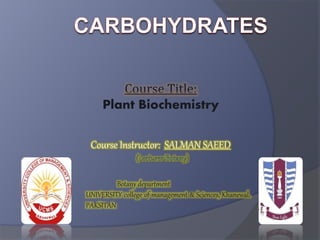
Carbohydrates by Salman Saeed Lecturer Botany UCMS Khanewal
- 1. Course Title: Plant Biochemistry Course Instructor: SALMAN SAEED Botany department UNIVERSITY college of management & Sciences, Khanewal, PAKSITAN
- 3. Carbohydrates Are compounds of tremendous biological and commercial importance. o The name Carbohydrates indicates that they are hydrates of Carbon, and contain carbon, hydrogen and oxygen. o Most of them contain hydrogen and oxygen in the ratio of 2:1.
- 4. Classes of Carbohydrates Monosaccharides composed of one unit of a polyhydroxy group Disaccharides are composed of two units Oligosaccharides are composed of 3-10 units Polysaccharides are composed of hundreds of thousands of units.
- 5. Carbohydrates and functional groups Carbohydrates are polyhydroxy aldehydes or ketones, or substances that yield such compounds in hydrolysis.
- 6. Monosaccharides contain a single polyhydroxy aldehyde or ketone unit. They are the simplest sugars and cannot be hydrolyzed into simpler compounds. • Their general formula is CnH2nOn,where n varies from 3 to7. The most important are the pentoses and hexoses
- 7. CLASSIFICATION OF CARBOHYDRATES • The naturally occurring carbohydrates may be classified into three main groups, particularly on the basis of their behaviour towards hydrolysis. • Monosaccharides are classified according to three different characteristics: the placement of its carbonyl group, the number of carbon atoms it contains, and its chiral handedness. • If the carbonyl group is an aldehyde, the monosaccharide is an aldose; if the carbonyl group is ketone, the monosaccharide is a ketose. Monosaccharides with three carbon atoms are called trioses; those with four are called tetroses; five are called pentoses; six are called hexoses.
- 8. Disaccharides Contain two monosaccharide units attached together. • Disaccharides are the most common oligosaccharides found in nature. Most of the naturally occurring representatives occur in plants, rather than animal sources. • The three most important disaccharides found free are sucrose, lactose, and maltose; a few others are cellobiose and trehalose. • Based on the type of linkage present in their molecule, the disaccharides are classified as follows:
- 9. Disaccharides Non Reducing Reducing C1—C1 Glycosidic linkage Trehalose C1—C2 Glycosidic linkage Sucrose C1—C4 Glycosidic linkage Lactose Maltose Cellobiose C1—C6 Glycosydic linkage Gentiobiose Melibiose Isomaltose
- 10. Polysaccharides Composed of very long chains of attached monosaccharides units Oligosaccharides are less common
- 11. Polysaccharides continued • Polysaccharides represent an important class of biological polymers. Their function in living organisms is usually either structure or storage related. Polysaccharides are high molecular weight carbohydrates which yield a large number of monosaccharides on hydrolysis and are further classified as: Homopolysaccharides • They contain only a single type of monosaccharide. Some homopolysaccharides serve as storage forms (starch and glycogen) and others serve as structural component in plant cell walls and animals exoskeletons (cellulose and chitin) Heteropolysaccharides • They contain more than one kind of monosaccharide.They are numerous in both plants and animals, agarose in plants and hyaluronic acid in animals.
- 12. Properties of Carbohydrates Physical Properties They are called sugars Taste sweet--- degree varies Fructose is the sweetest Solid at room temperature Soluble in water solubility helps in carbs to be transported quickly.
- 13. Why do we need Carbohydrates to survive? To provide the body with energy. To help the central nervous system, the kidneys, the brain, the muscles (including the heart), to function properly. Aids in intestinal health and waste elimination.
- 14. Carbohydrates
- 15. Carbohydrates MONOSACCHARIDES: • Glucose • Fructose • Galactose DISACCHARIDES: • Lactose • Maltose • Sucrose POLYSACCHARIDES: • Starch • Glycogen • Cellulose
- 16. Carbohydrates
- 17. Without ADEQUATE carbohydrates…?? Muscle tissue breakdown Fatigue Brain power diminishes Body will go into ketosis Nausea Mood swings Weakness Dizziness Bad breath Depression
